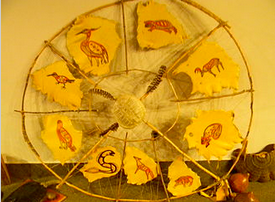The
Kortright Centre for Centre for Conservation is primarily an education and demonstration centre for environment and renewable energy. However, because its site, just north of Toronto, encompasses a significant Aboriginal archaeological site, it has always had a natural connection with First Nations history and culture. Today, that connection is deepening, as Kortright is working to incorporate an Aboriginal perspective throughout its programming.
For 25 years, a program called the Boyd Archaeological Field School brought students to excavate on the Kortright property every year. It has now moved to a different site in Durham region, but in the course of that quarter century, “a million artifacts came out of the ground,” says Kortright Centre teacher Aldo Missio.
The work uncovered a Huron-Wendat site that was once a settlement of 2,000 to 3,000 people living in at least 22 longhouses, dating from the 1500s, “so it’s precontact for this part of Ontario,” Missio points out. It’s important because it represents one point along a gradual migration by the Huron-Wendat; the Durham site dates to an even earlier stage.
“We’ll never know the full size of the site,” Missio says. “Two-thirds of it was destroyed by gravel extraction for Highway 400. That was before archaeology became a legislative requirement for construction and development, which it is now.”
 Iroquoian tribe totems.
Iroquoian tribe totems.
Missio himself became involved in the archaeological course in 1997 and has helped Kortright’s educational programming to develop from that time. “The original programming about early Aboriginal lifeways developed out of [the excavation],” he says. When he took on his current role about three years ago, staff was still working with an archaic slide carousel for their introductory presentations: “There was definitely room for some updating.”
When the centre’s staff most recently reviewed its Strategic Plan, which runs for ten years beginning in 2013, they made sure to include the tenet that “Anishinaabe, Haudenosaunee, Huron-Wendat and Métis narratives of community life and their relationship with the land are integrated into TRCA programs and activities.”
“There are several key strategies, and one of them is telling the story of the Toronto region,” says Missio. This idea is embedded in all Kortright’s educational activities, which include formal programming for school groups aligned with sections of the Ontario elementary curriculum, as well as events for adult audiences, summer day camps and resources for home schooling.
The current education program overview states that “while the program looks to the past, as part of the history curriculum, it also recognizes Aboriginal people as a living culture, and an important part of the Canadian mosaic.” For this reason, says Missio, “We maintain contact with the Wendat, because we are excavating a site belonging to their ancestors.”
The educational program overview also states that “we seek to avoid stereotypes and inaccuracies. While our program is rooted in the past, we use the present tense as much as possible to portray Aboriginal cultures as active, living members of the Canadian mosaic, and not an extinct people of the past.”
One part of the school programming involves a “shopping trip” through the forest in search of food, medicines and building materials, “but stressing that you still have to do that sustainably, and that’s why [Aboriginal peoples] were able to survive in this environment for thousands of years,” he says.
“That’s part of developing people’s sense of place, but it’s all tied together with looking at the environment and sustainability. That’s one of the keys, because indigenous people lived in harmony with nature for thousands of years before European settlers were here. I think that’s a common theme with what we’re trying to do with Kortright. In a sense, there’s almost an alliance there. I like of thinking of alliances,” he adds, “because that’s how Canada was formed: as a set of alliances between Aboriginal people and settlers.”
Missio is literally building alliances with community partners like Mary McCue, Curriculum Liaison in the area of First Nations, Metis and Inuit Education with
York Region District School Board. “He invited me and my colleagues to see if we had any suggestions,” says McCue, who is herself a a member of the Chippewas of Georgina Island.
“They’ve gone above and beyond, as far as I’m concerned,” she says. “Aldo’s been very aware of being sensitive of the culture, the authentic voice, and being very careful not to appropriate any of the culture. He’s very knowledgeable and very thorough—he’s actually taught me stuff. So it is a very good working relationship.”
Missio has plans to move further in this direction. “The focus for me is now look at some of the other programs and try to work in some Aboriginal perspectives that the staff are comfortable with and that’s authentic,” he says. “I think we’ve done a good job with some of the basic Aboriginal life programs, and now [we’ll be] trying to put some content into some other programs as well.”